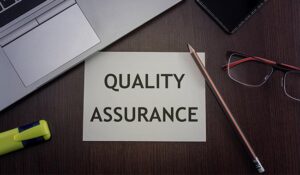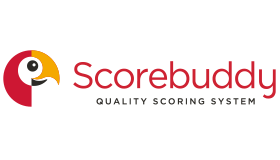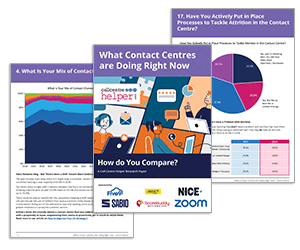This blog summarizes the key points from a recent article from David McGeough at Scorebuddy, where he provides a step-by-step guide on how to implement an effective call centre QA program.
Customer satisfaction has never been more crucial – 95% of contact centre professionals rank it as the top priority when it comes to call centre metrics. To maintain strong CSAT scores, a well-designed QA program is essential.
However, simply installing QA software won’t guarantee success. A clear and strategic plan for launching and maintaining your program is essential.
12 Steps to Launching a Call Centre QA Program
1. Secure Buy-In From Key Stakeholders
For your call centre QA program to succeed, it’s crucial to gain the support of key stakeholders. Without the endorsement of senior leadership, operations, HR, and others, your program may struggle to gain traction.
Position QA as a powerful tool to enhance customer service, streamline operations, and boost employee performance, not just a compliance measure.
Tailor your approach to each stakeholder’s interests, whether it’s showing revenue potential to executives or highlighting cost savings for operations.
Additionally, remain receptive to their input on how the QA program should be structured. Their feedback will help shape a stronger business case for the initiative.
2. Develop a Plan for Change Management
Introducing a new QA program often requires changes in behaviour, processes, and mindsets. Agents may initially be wary, so presenting QA as a tool for professional growth and not punitive measures is essential.
Craft a change management strategy that minimizes resistance. Highlight how QA benefits performance without adding undue pressure. Offer training and open communication to ensure everyone, from agents to managers, is on board and understands the process.
3. Define Clear QA Objectives Aligned With Business Goals
Before implementing your QA program, outline clear objectives that tie into your broader business goals. What do you want to improve – customer satisfaction, agent productivity, or compliance? Setting clear KPIs ensures that your efforts align with organizational targets.
Work with leadership to identify the most relevant metrics, such as CSAT, FCR, AHT, and NPS, and set SMART goals like “Reduce repeat calls by 10% in six months by enhancing FCR” to make measurable improvements.
4. Establish Clear QA Standards
Your QA standards lay the groundwork for a successful evaluation process. Defining what constitutes “good” service ensures consistency in reviews and leads to actionable insights.
Create a framework that includes criteria like greeting quality, professionalism, empathy, product knowledge, and compliance. Make sure the standards align with your industry requirements, such as PCI-DSS, HIPAA, or GDPR, and provide a solid foundation for evaluations.
5. Train Your QA Analysts and Supervisors
Well-trained QA teams are essential to maintaining fairness in evaluations. Analysts and supervisors should understand scoring guidelines and best practices to offer valuable feedback and identify areas for improvement.
Ensure your QA team is fully aligned on evaluation criteria, scoring guidelines, and effective coaching techniques. Regular supervisor reviews will maintain consistency and fairness in assessments.
6. Create Detailed QA Scorecards
A structured QA scorecard helps you evaluate agent performance, track trends, and identify opportunities for improvement. A vague or overly complex scorecard can undermine the process, so aim for clarity and focus.
Your scorecard should cover key areas such as call resolution, compliance, and communication skills. Keep it simple yet comprehensive, ensuring evaluators can focus on the most important performance indicators.
7. Build a Call Monitoring and Review Process
A structured process is vital for maintaining organization in your QA efforts. Develop a system for selecting, reviewing, and acting on calls to ensure a smooth and continuous feedback loop.
Decide on the frequency and criteria for call reviews, whether they’re random or based on specific agent segments. Define how feedback will be delivered – real-time coaching or written evaluations – and integrate it into your existing coaching framework.
8. Hold Regular Calibration Sessions
Calibration sessions ensure consistency and fairness in scoring. Without them, evaluations may differ from one analyst to another, leading to confusion. These sessions align evaluators on standards and allow for the refinement of scoring practices.
Regularly review sample calls as a team and discuss any discrepancies to fine-tune your scoring system. Calibration should be a collaborative process that includes agent feedback for improved transparency and trust.
9. Choose Effective QA Software
Implementing the right QA software is a game changer. It can centralize call recordings, automate workflows, and provide real-time insights into agent performance, making your evaluations more efficient.
Look for a solution that integrates well with existing tools and offers AI-powered features like automated scoring, speech analytics, and customizable dashboards to streamline the evaluation process.
10. Implement Structured Feedback and Coaching Systems
For your QA efforts to lead to real improvements, feedback must be clear, timely, and constructive. Structured coaching systems help agents understand their performance and have actionable plans for growth.
Establish a feedback loop where evaluations lead to specific coaching sessions. Incorporate methods like the feedback sandwich or the 3:1 ratio to keep coaching balanced, focusing on strengths as well as areas for improvement.
11. Leverage QA Data for Continuous Improvement
The data gathered through QA provides insights into agent performance, customer behavior, and operational efficiencies. Use this information to identify trends, predict training needs, and find opportunities for process optimization.
By analyzing metrics like FCR, NPS, and compliance adherence, you can shift from reactive to proactive improvement, driving better results across the board.
12. Regularly Review and Adjust Your QA Program
A successful QA program is a dynamic process that requires regular updates to stay relevant. As customer expectations evolve, your QA strategy must adapt to meet new demands.
Gather feedback from agents, supervisors, and customers to assess the effectiveness of your program. Use quarterly reviews to refine scoring trends, ensure calibration consistency, and evaluate coaching impact, keeping your QA program aligned with business goals and evolving standards.
This blog post has been re-published by kind permission of Scorebuddy – View the Original Article
For more information about Scorebuddy - visit the Scorebuddy Website
Call Centre Helper is not responsible for the content of these guest blog posts. The opinions expressed in this article are those of the author, and do not necessarily reflect those of Call Centre Helper.
Author: Scorebuddy
Reviewed by: Jo Robinson
Published On: 28th Mar 2025
Read more about - Guest Blogs, David McGeough, Scorebuddy






 Scorebuddy is quality assurance solution for scoring customer service calls, emails and web chat. It is a dedicated, stand-alone staff scoring system based in the cloud, requiring no integration.
Scorebuddy is quality assurance solution for scoring customer service calls, emails and web chat. It is a dedicated, stand-alone staff scoring system based in the cloud, requiring no integration. 









